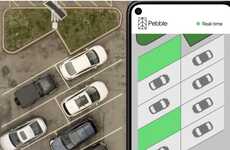
Nokia's Road Experiment
In an effort to find a cheaper alternative to permanent road sensors, Nokia conducted a large-scale experiment to test how cell phones can monitor and predict traffic. The experiment was in collaboration with the California Center for Innovative Transportation (CCIT), CalTrans, and Berkeley's Department of Civil and Environmental Engineering. In the all day experiment, 100 UC Berkeley students drove a 10-mile stretch of the nearby 880 freeway.
"Each student car was issued a Nokia N95 phone with GPS and special traffic-monitoring software developed by Nokia's Palo Alto, Calif.-based research lab--plus a Bluetooth headset," News.com detailed. "As the students drove the freeway, the phone sent data about each car's speed and position back to the company's research facility. The data is compiled and used to predict traffic patterns and help drivers get where they need to be quickly."
Nokia Chief Technology Officer Bob Iannucci, who was on hand for the field test, said this particular project is moving at a more aggressive pace than most of Nokia's research because of the potential impact of the experiment. He hopes to expand the experiment from 100 to possibly 1,000 people soon. And instead of participating in a one-day test, users would be invited to use the traffic monitoring software in the course of their daily routines.
"Each student car was issued a Nokia N95 phone with GPS and special traffic-monitoring software developed by Nokia's Palo Alto, Calif.-based research lab--plus a Bluetooth headset," News.com detailed. "As the students drove the freeway, the phone sent data about each car's speed and position back to the company's research facility. The data is compiled and used to predict traffic patterns and help drivers get where they need to be quickly."
Nokia Chief Technology Officer Bob Iannucci, who was on hand for the field test, said this particular project is moving at a more aggressive pace than most of Nokia's research because of the potential impact of the experiment. He hopes to expand the experiment from 100 to possibly 1,000 people soon. And instead of participating in a one-day test, users would be invited to use the traffic monitoring software in the course of their daily routines.
Trend Themes
1. Cell Phone Traffic Monitoring - Using cell phones equipped with GPS and traffic-monitoring software to collect data and predict traffic patterns.
2. Temporary Sensor Alternatives - Seeking cheaper alternatives to permanent road sensors by utilizing existing technology.
3. Crowdsourced Traffic Data - Harnessing the power of a large number of drivers to collect real-time traffic data for analysis and prediction.
Industry Implications
1. Mobile Technology - Exploring the capabilities of GPS-enabled cell phones to revolutionize traffic monitoring.
2. Transportation - Adapting existing traffic infrastructure to incorporate innovative solutions like cell phone traffic monitoring.
3. Smart City - Leveraging crowdsourced data and advanced technology to optimize traffic flow in urban areas.
3.2
Score
Popularity
Activity
Freshness























